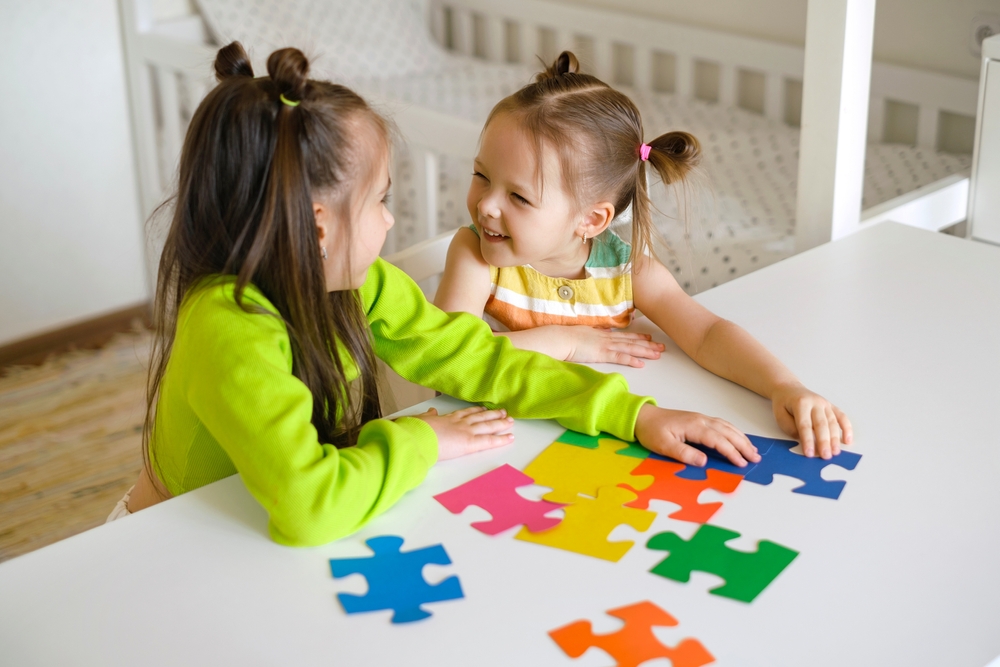Autism doesn’t discriminate.
Whether you’re a girl or boy, autism spectrum disorder (ASD) can affect anyone, regardless of gender. However, research has shown that boys are diagnosed with autism more often than girls.
According to a 2021 study by the CDC (Centers for Disease Control and Prevention), boys are 4 times more likely to receive an autism diagnosis than girls.
Why the disparity? The reasons for the greater prevalence of ASD in boys are still being debated. While boys often exhibit more visible traits, such as repetitive behaviors and social difficulties, girls tend to internalize struggles. Many girls with autism mask their symptoms by mimicking others, making it harder to recognize and diagnose.
So how can you tell if your child, whether boy or girl, may have ASD? What are the key differences in how autism manifests across genders?
This is where Heartlinks can help.
With an official diagnosis, we can provide your autistic child with personalized ABA (applied behavior analysis) therapy and different services to support them, because every child deserves the chance to reach their full potential, no matter their gender.
What is Autism?
Autism is a developmental and neurological disorder that affects an individual’s learning, behavior, and interactions. It exhibits deficits in interaction skills, weaknesses in social communication (both verbal and nonverbal), and repetitive or restricted behaviors. While the exact causes of autism remain unknown, research suggests a combination of genetic and environmental factors lead to its development.
Understanding autism’s effect on the brain is important, as studies show critical differences in brain structure, connectivity, and processing for those on the spectrum. Regardless of gender, people on the spectrum have unique patterns of brain activity that affect how they perceive sensory input, process emotions, and engage in social interactions.
Signs and Symptoms of Autism
Autism symptoms can vary depending on age and individual differences. Some early signs in babies and toddlers, may include:
- Lack of eye contact
- Delayed speech or babbling
- Limited facial expressions
- Not responding to their name
- Repetitive movements (i.e., spinning or hand flapping)
- As autistic children grow, symptoms in teenagers may present differently, such as:
- Difficult with social interactions
- Trouble understanding sarcasm or non-literal language
- Heightened sensitivity to sensory output (i.e. sensory processing disorder)
- Highly structured routines and intense focus on hobbies.
Why are Autistic Traits in Girls Often Missed?
Despite having the same diagnostic criteria and clinical signs for both genders, there is still a much higher diagnostic rate in boys than in girls. According to research, girls are being diagnosed 2-3 years later than boys. There are many theories as to why this is the case, including differences in how symptoms present in girls vs. boys with autism.
Social Masking and Camouflaging
Girls with autism may consciously or unconsciously mimic social behaviors, making their challenges less obvious. They often observe and imitate their peers, allowing them to blend in despite struggling internally.
Misdiagnosis or Late Diagnosis
Thanks in part to the capacity to mask symptoms, autistic girls are often misdiagnosed with conditions including anxiety, ADHD and depression, instead of autism. This can lead to a later diagnosis, causing them to miss out on early intervention that can provide tremendous support. Additionally, autism often co-occurs with other conditions such as Down Syndrome, Pervasive Developmental Disorder, and seizures.
Differences in Symptom Presentation
Traditional diagnostic criteria are based on how autism presents in boys. Girls may exhibit less obvious repetitive behaviors, develop more socially acceptable interests (e.g. books, dolls, or celebrities) and display stronger verbal communication skills than their male counterparts.
Fewer Behavioral Issues
Often girls with autism tend to be quieter, more introverted, and less likely to exhibit disruptive behaviors. This makes their difficulties unnoticed by parents, teachers, and sometimes certified ABA therapists.
Greater Social Motivation
Girls on the spectrum may strongly desire to make friends, even if they struggle with maintaining relationships. Despite not having social skills, their difficulties may be misinterpreted as shyness or anxiety rather than autism.
Bias in Research and Diagnosis
The majority of autism research and diagnostic methods have traditionally focused on male traits, leading to a gross underrepresentation of female characteristics in assessments.
What are the Differences in Autism Between Boys and Girls?
Although autism presents in both genders, the symptoms can look quite different. Here are some key distinctions:
- Girls tend to use non-verbal communication such as pointing and gazing, and are better at staying focused.
- Boys often have limited play interests (i.e., only playing with Lego), while girls display broader interests and are less repetitive.
- Girls can handle the early social demands of childhood, but they run into difficulties later in life when they enter adolescence. Whereas boys tend to show problems earlier.
- Depression and anxiety are more common in autistic girls than boys.
- Boys on the spectrum often engage in disruptive behavior (e.g., harmful behavior) to obtain objects. At the same time, girls are more likely to have emotional outbursts such as tantrums to gain attention.
- Girls tend to have traditional interests for their gender (i.e., movie stars and rock singers). Boys tend to prefer more untraditional interests such as statistics, schedules, and transportation.
What is an internal presentation of autism?
Instances where individuals on the spectrum, particularly girls and women, internalize their autistic traits and challenges instead of outwardly demonstrating them is called an internal presentation of autism. It is more common in boys and men.
Anxiety
Anxiety is commonly internalized by autistic girls, often manifesting in ways that are overlooked or misattributed to other conditions. Many girls on the spectrum exhibit selective mutism, where they’re unable to speak in certain social situations and often recoil from speaking in public areas. While they may be super chatty with close friends, they quickly become muted, meek, or quiet when introduced to others. This difficulty in navigating social interactions can contribute to heightened anxiety, which may manifest in physical symptoms such as stomachaches.

Many autistic girls also experience eating disorders and food aversions can be a symptom of internalized autism, as they often stem from sensory sensitivities, a need for control, or anxiety.
Emotional
Autistic girls may exhibit intense empathy for people, inanimate objects, and animals. This strong emotional connection can manifest in a deep love for animals, often leading them to pretend to be cats or other animals to express themselves. Managing these intense emotions can sometimes be difficult, requiring support in emotional regulation to help them process and express their feelings in a balanced way.
Socially and emotionally they may appear younger than their peers, struggling to navigate the complexities of age-appropriate interactions.
How can ABA be tailored to boys differently from girls?
Given the differences in girls with autism vs. boys with autism, ABA therapy, which is considered the best type of autism treatment, needs to address each child’s strengths and weaknesses. However, since autism presents differently in boys vs. girls, ABA therapy must be adapted to meet their unique needs.
Addressing Socialization Differences
Boys with autism often struggle with direct social interactions, displaying more overt social difficulties including maintaining conversations and understanding social cues. To address this, discrete trial training (DTT) and social skills therapy could be used to teach explicit social skills.
In contrast, with girls better able to mask their difficulties by mimicking others, they would benefit from natural environment teaching (NET) and modeling to help them learn how to build authentic social connections.
Recognizing Behavioral Differences
Boys on the spectrum often demonstrate externalizing behaviors such as aggression, hyperactivity, or stimming. To address these challenges, task analysis can break down self-regulation strategies into manageable steps, helping boys learn impulse control. Shaping can also reinforce gradual improvements in behavior by rewarding small steps toward desired actions, using coping strategies instead of reacting aggressively. Additionally, positive reinforcement, such as offering preferred rewards for appropriate behavior, will encourage boys to adopt more socially acceptable responses.
In contrast, girls on the spectrum are more prone to internalizing behaviors, including anxiety, withdrawal, or excessive compliance, making their struggles more challenging to detect. Social stories can be used to help girls navigate complex social situations. Naturalistic ABA therapy strategies can reinforce emotional expression in real-life settings, encouraging girls to communicate their feelings more openly.
Adjusting Interests and Motivation Strategies
As indicated earlier, boys on the spectrum often develop focused interests in specific topics such as video games, sports or trains. These can be leveraged as reinforcers and motivators for learning new skills. Social skills ABA therapy can effectively integrate these interests into structured learning opportunities, ensuring boys remain engaged while developing essential social and cognitive skills. Additionally, discriminative stimulus techniques will help boys appropriately recognize when and how to engage with their interests in social contexts, such as transitioning from play to conversation with peers.
On the other hand, girls usually have socially acceptable interests, such as fictional characters, books, or animals, which often makes their autistic symptoms less noticeable. Token economy systems can help girls navigate social expectations and interactions related to their interests by rewarding positive behaviors with tokens, which can be exchanged for preferred activities or objects. Error correction techniques can also be applied when teaching girls how to expand their conversations beyond their favorite topics, enabling them to develop more balanced and reciprocal communication skills.
Heartlinks ABA: Treatment for Boys and Girls
Learning the differences in how autism presents in boys and girls is essential for ensuring that every child receives the appropriate support they need to thrive. While boys may display more overt symptoms, girls are often better at masking theirs. Tailoring ABA therapy to meet each autistic child’s needs is critical in providing effective interventions.
At Heartlinks, we’re proud to offer customized ABA therapy programs at all our locations, including New Jersey, Indiana, Georgia, and North Carolina. Our therapies foster growth, independence, and confidence. If you’re looking for export support for your autistic child, contact Heartlinks ABA today, to learn more about our services and how we can help your child thrive.
